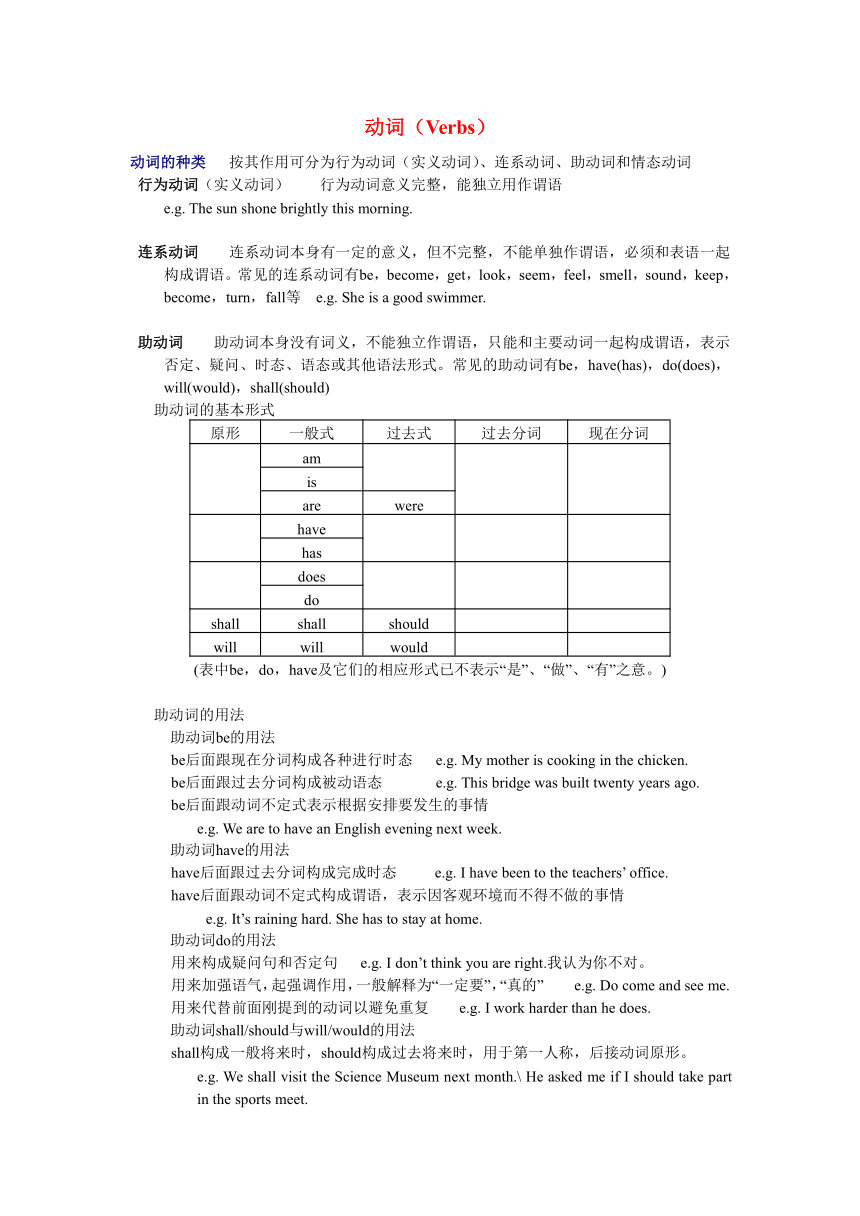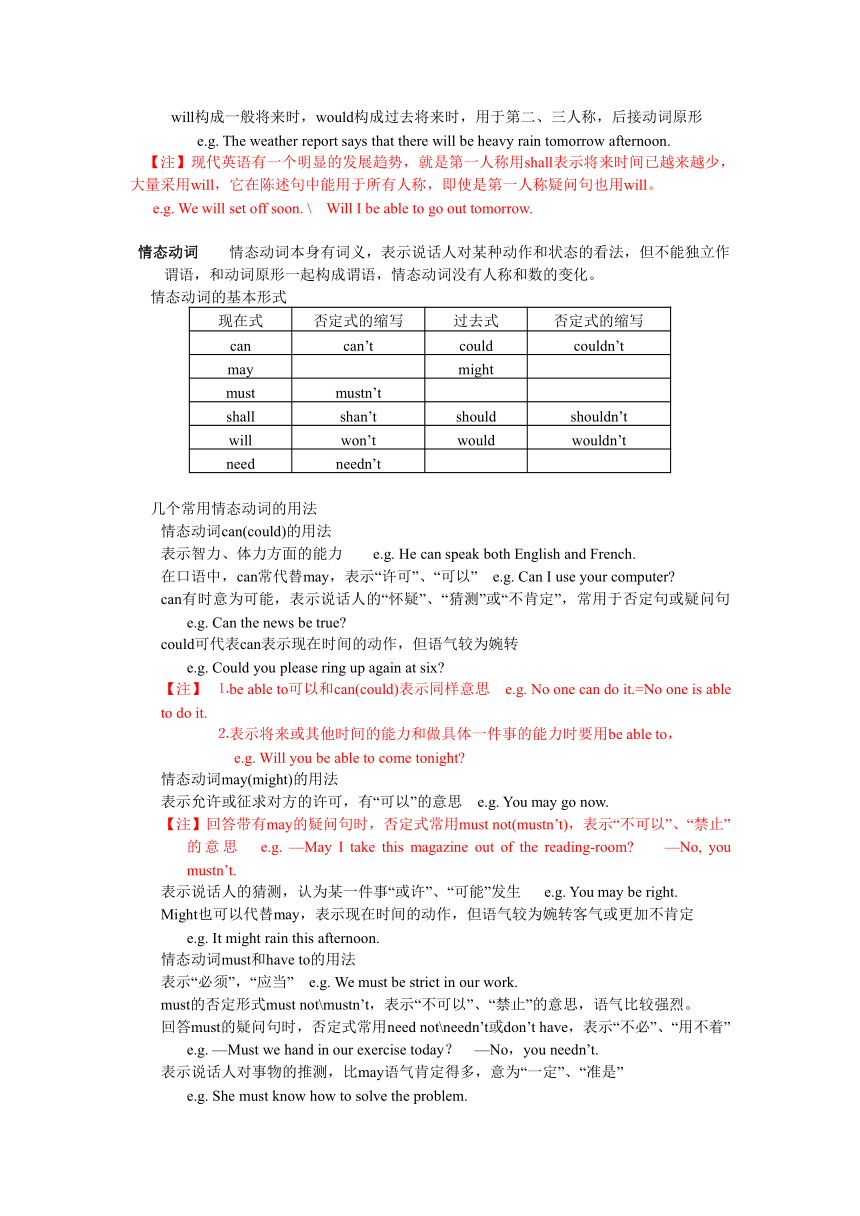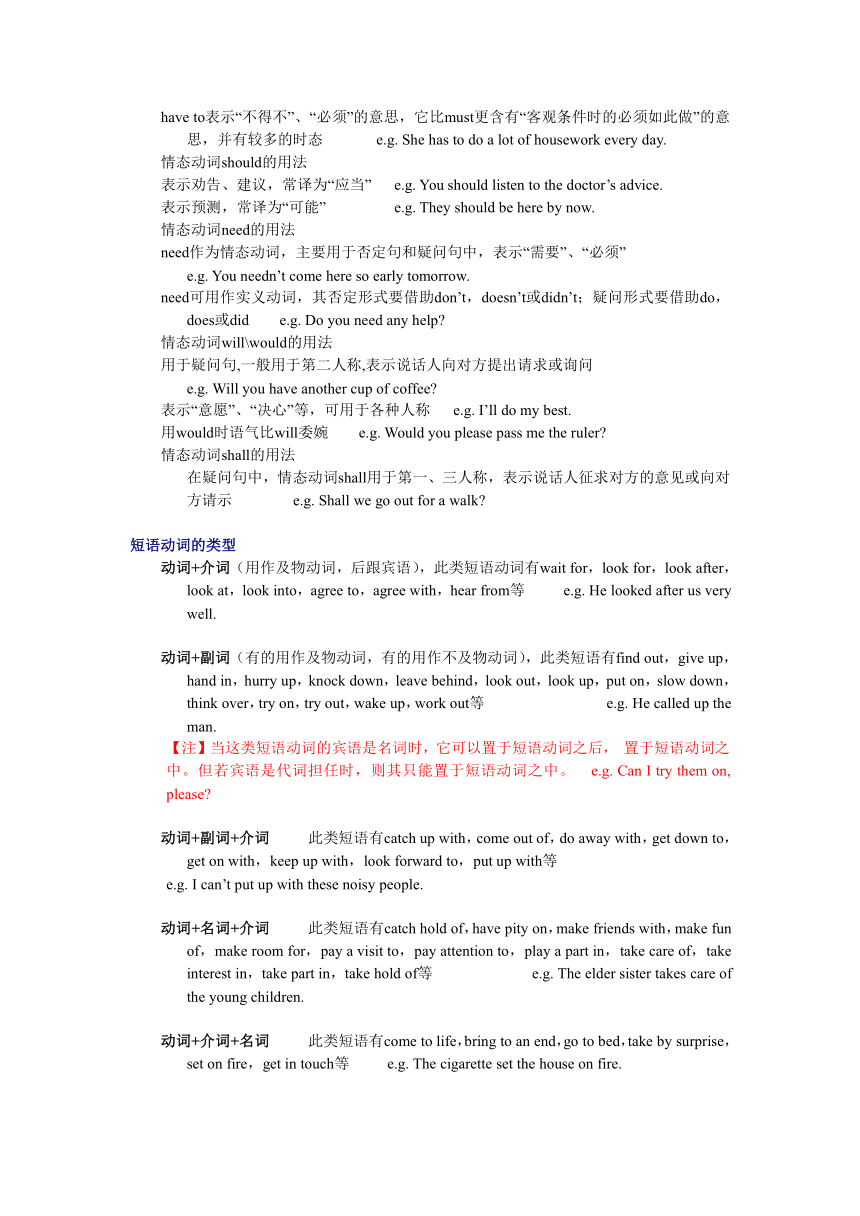语法全套资料(新)-动词
图片预览



文档简介
动词(Verbs)
动词的种类 按其作用可分为行为动词(实义动词)、连系动词、助动词和情态动词
行为动词(实义动词) 行为动词意义完整,能独立用作谓语
e.g. The sun shone brightly this morning.
连系动词 连系动词本身有一定的意义,但不完整,不能单独作谓语,必须和表语一起构成谓语。常见的连系动词有be,become,get,look,seem,feel,smell,sound,keep,become,turn,fall等 e.g. She is a good swimmer.
助动词 助动词本身没有词义,不能独立作谓语,只能和主要动词一起构成谓语,表示否定、疑问、时态、语态或其他语法形式。常见的助动词有be,have(has),do(does),will(would),shall(should)
助动词的基本形式
原形 一般式 过去式 过去分词 现在分词
am
is
are were
have
has
does
do
shall shall should
will will would
(表中be,do,have及它们的相应形式已不表示“是”、“做”、“有”之意。)
助动词的用法
助动词be的用法
be后面跟现在分词构成各种进行时态 e.g. My mother is cooking in the chicken.
be后面跟过去分词构成被动语态 e.g. This bridge was built twenty years ago.
be后面跟动词不定式表示根据安排要发生的事情
e.g. We are to have an English evening next week.
助动词have的用法
have后面跟过去分词构成完成时态 e.g. I have been to the teachers’ office.
have后面跟动词不定式构成谓语,表示因客观环境而不得不做的事情
e.g. It’s raining hard. She has to stay at home.
助动词do的用法
用来构成疑问句和否定句 e.g. I don’t think you are right.我认为你不对。
用来加强语气,起强调作用,一般解释为“一定要”,“真的” e.g. Do come and see me.
用来代替前面刚提到的动词以避免重复 e.g. I work harder than he does.
助动词shall/should与will/would的用法
shall构成一般将来时,should构成过去将来时,用于第一人称,后接动词原形。
e.g. We shall visit the Science Museum next month.\ He asked me if I should take part in the sports meet.
will构成一般将来时,would构成过去将来时,用于第二、三人称,后接动词原形
e.g. The weather report says that there will be heavy rain tomorrow afternoon.
【注】现代英语有一个明显的发展趋势,就是第一人称用shall表示将来时间已越来越少,大量采用will,它在陈述句中能用于所有人称,即使是第一人称疑问句也用will。
e.g. We will set off soon. \ Will I be able to go out tomorrow.
情态动词 情态动词本身有词义,表示说话人对某种动作和状态的看法,但不能独立作谓语,和动词原形一起构成谓语,情态动词没有人称和数的变化。
情态动词的基本形式
现在式 否定式的缩写 过去式 否定式的缩写
can can’t could couldn’t
may might
must mustn’t
shall shan’t should shouldn’t
will won’t would wouldn’t
need needn’t
几个常用情态动词的用法
情态动词can(could)的用法
表示智力、体力方面的能力 e.g. He can speak both English and French.
在口语中,can常代替may,表示“许可”、“可以” e.g. Can I use your computer
can有时意为可能,表示说话人的“怀疑”、“猜测”或“不肯定”,常用于否定句或疑问句 e.g. Can the news be true
could可代表can表示现在时间的动作,但语气较为婉转
e.g. Could you please ring up again at six
【注】 ⒈be able to可以和can(could)表示同样意思 e.g. No one can do it.=No one is able to do it.
⒉表示将来或其他时间的能力和做具体一件事的能力时要用be able to,
e.g. Will you be able to come tonight
情态动词may(might)的用法
表示允许或征求对方的许可,有“可以”的意思 e.g. You may go now.
【注】回答带有may的疑问句时,否定式常用must not(mustn’t),表示“不可以”、“禁止”的意思 e.g. —May I take this magazine out of the reading-room —No, you mustn’t.
表示说话人的猜测,认为某一件事“或许”、“可能”发生 e.g. You may be right.
Might也可以代替may,表示现在时间的动作,但语气较为婉转客气或更加不肯定
e.g. It might rain this afternoon.
情态动词must和have to的用法
表示“必须”,“应当” e.g. We must be strict in our work.
must的否定形式must not\mustn’t,表示“不可以”、“禁止”的意思,语气比较强烈。
回答must的疑问句时,否定式常用need not\needn’t或don’t have,表示“不必”、“用不着” e.g. —Must we hand in our exercise today? —No,you needn’t.
表示说话人对事物的推测,比may语气肯定得多,意为“一定”、“准是”
e.g. She must know how to solve the problem.
have to表示“不得不”、“必须”的意思,它比must更含有“客观条件时的必须如此做”的意思,并有较多的时态 e.g. She has to do a lot of housework every day.
情态动词should的用法
表示劝告、建议,常译为“应当” e.g. You should listen to the doctor’s advice.
表示预测,常译为“可能” e.g. They should be here by now.
情态动词need的用法
need作为情态动词,主要用于否定句和疑问句中,表示“需要”、“必须”
e.g. You needn’t come here so early tomorrow.
need可用作实义动词,其否定形式要借助don’t,doesn’t或didn’t;疑问形式要借助do,does或did e.g. Do you need any help
情态动词will\would的用法
用于疑问句,一般用于第二人称,表示说话人向对方提出请求或询问
e.g. Will you have another cup of coffee
表示“意愿”、“决心”等,可用于各种人称 e.g. I’ll do my best.
用would时语气比will委婉 e.g. Would you please pass me the ruler
情态动词shall的用法
在疑问句中,情态动词shall用于第一、三人称,表示说话人征求对方的意见或向对方请示 e.g. Shall we go out for a walk
短语动词的类型
动词+介词(用作及物动词,后跟宾语),此类短语动词有wait for,look for,look after,look at,look into,agree to,agree with,hear from等 e.g. He looked after us very well.
动词+副词(有的用作及物动词,有的用作不及物动词),此类短语有find out,give up,hand in,hurry up,knock down,leave behind,look out,look up,put on,slow down,think over,try on,try out,wake up,work out等 e.g. He called up the man.
【注】当这类短语动词的宾语是名词时,它可以置于短语动词之后, 置于短语动词之中。但若宾语是代词担任时,则其只能置于短语动词之中。 e.g. Can I try them on, please
动词+副词+介词 此类短语有catch up with,come out of,do away with,get down to,get on with,keep up with,look forward to,put up with等
e.g. I can’t put up with these noisy people.
动词+名词+介词 此类短语有catch hold of,have pity on,make friends with,make fun of,make room for,pay a visit to,pay attention to,play a part in,take care of,take interest in,take part in,take hold of等 e.g. The elder sister takes care of the young children.
动词+介词+名词 此类短语有come to life,bring to an end,go to bed,take by surprise,set on fire,get in touch等 e.g. The cigarette set the house on fire.
be+形容词+介词 此类短语有be afraid of,be fond of,be angry with/at,be strict with,be good at,be worried about,be weak in,be interested in,be proud of,be tired of,be sick of,be surprised at等 e.g. She was afraid of snakes.
及物动词和不及物动词
及物动词必须带宾语,表示动作的对象 e.g. I like music.
不及物动词不能或不需带宾语 e.g. The wind is blowing hard.
多数动词既可作及物动词,又可作不及物动词
e.g. I hear your father has left Beijing for Tokyo.(及物动词) \ When did he leave (不及物动词)
动词的基本形式 动词有四种基本形式:动词原形、过去式、过去分词和现在分词
规则动词的过去式和过去分词是在原形动词后面加-ed构成,现在分词是在原形动词后面加-ing构成
规则动词加-ed构成过去式和过去分词的情况及其读音详见下表:
词形 读音 在清辅音后读/t/ 在元音和浊辅音后读/d/ 在辅音/t//d/后读/id/
一般动词加-ed asked, helped, finished, worked played, answered, opened, called, entered wanted, needed, repeated
以e结尾的动词后加-d hoped, liked lived, died, tied, changed
以辅音字母加y结尾的动词,先将y改为i,再加-ed studied, tried, carried, cried, worried
以重度闭音节或r结尾而且末尾只有一个辅音字母的动词,先双写辅音字母,再加-ed stopped, dropped planned, referred, begged regretted, permitted, admitted
规则动词加-ing构成现在分词的情况详见下表:
词 形 加-ing 例 词
一般动词 加-ing see—seeing,ski—skiing
以不发音的字母e结尾的动词 先去e,再加-ing become—becoming,use—using
以重度闭音节结尾,末尾又只有一个辅音字母的动词 将末尾辅音字母双写,再加-ing begin—beginning, sit—sitting,plan—planning,stop—stopping
以ie结尾的动词 将ie变为y,再加-ing die—dying,lie—lying,tie—tying
不规则动词 则详见不规则动词表
不规则动词表
现在式 过去式 过去分词
am, is was been
are were been
babysit babysat babysat
become became become
bend bent bent
begin began begun
bite bit bitten
bleed bled bled
blow blew blown
break broke broken
bring brought brought
build built built
burn burnt/burned burnt/burned
buy bought bought
can could -
catch caught caught
choose chose chosen
come came come
cost cost cost
cut cut cut
dig dug dug
do, does did done
draw drew drawn
drink drank drunk
drive drove driven
eat ate eaten
fall fell fallen
feed fed fed
feel felt felt
fight fought fought
find found found
fly flew flown
forget forgot forgotten
freeze froze frozen
forgive forgave forgiven
get got got
give gave given
go went gone
grow grew grown
has, have had had
hear heard heard
hide hid hidden
hit hit hit
hold held held
hurt hurt hurt
keep kept kept
know knew known
lay laid laid
leap leapt/leaped leapt/leaped
learn learnt/learned learnt/learned
leave left left
lend lent lent
let let let
lie lay lain
light lit/lighted lit/lighted
lose lost lost
make made made
may might -
mean meant meant
meet met met
pay paid paid
put put put
read read read
retell retold retold
ride rode ridden
ring rang rung
rise rose risen
run ran run
say said said
see saw seen
seek sought sought
sell sold sold
send sent sent
set set set
shake shook shaken
shall should -
shine shone shone
shoot shot shot
show showed shown
sing sang sung
sit sat sat
sleep slept slept
smell smelt smelt
speak spoke spoken
spell spelt spelt
spend spent spent
spread spread spread
stand stood stood
steal stole stolen
stick stuck stuck
swim swam swum
swing swung swung
take took taken
teach taught taught
tear tore torn
tell told told
think thought thought
throw threw thrown
tread trod trod / trodden
understand understood understood
upset upset upset
wake woke/waked woken/waked
wear wore worn
will would -
win won won
write wrote written
动词的种类 按其作用可分为行为动词(实义动词)、连系动词、助动词和情态动词
行为动词(实义动词) 行为动词意义完整,能独立用作谓语
e.g. The sun shone brightly this morning.
连系动词 连系动词本身有一定的意义,但不完整,不能单独作谓语,必须和表语一起构成谓语。常见的连系动词有be,become,get,look,seem,feel,smell,sound,keep,become,turn,fall等 e.g. She is a good swimmer.
助动词 助动词本身没有词义,不能独立作谓语,只能和主要动词一起构成谓语,表示否定、疑问、时态、语态或其他语法形式。常见的助动词有be,have(has),do(does),will(would),shall(should)
助动词的基本形式
原形 一般式 过去式 过去分词 现在分词
am
is
are were
have
has
does
do
shall shall should
will will would
(表中be,do,have及它们的相应形式已不表示“是”、“做”、“有”之意。)
助动词的用法
助动词be的用法
be后面跟现在分词构成各种进行时态 e.g. My mother is cooking in the chicken.
be后面跟过去分词构成被动语态 e.g. This bridge was built twenty years ago.
be后面跟动词不定式表示根据安排要发生的事情
e.g. We are to have an English evening next week.
助动词have的用法
have后面跟过去分词构成完成时态 e.g. I have been to the teachers’ office.
have后面跟动词不定式构成谓语,表示因客观环境而不得不做的事情
e.g. It’s raining hard. She has to stay at home.
助动词do的用法
用来构成疑问句和否定句 e.g. I don’t think you are right.我认为你不对。
用来加强语气,起强调作用,一般解释为“一定要”,“真的” e.g. Do come and see me.
用来代替前面刚提到的动词以避免重复 e.g. I work harder than he does.
助动词shall/should与will/would的用法
shall构成一般将来时,should构成过去将来时,用于第一人称,后接动词原形。
e.g. We shall visit the Science Museum next month.\ He asked me if I should take part in the sports meet.
will构成一般将来时,would构成过去将来时,用于第二、三人称,后接动词原形
e.g. The weather report says that there will be heavy rain tomorrow afternoon.
【注】现代英语有一个明显的发展趋势,就是第一人称用shall表示将来时间已越来越少,大量采用will,它在陈述句中能用于所有人称,即使是第一人称疑问句也用will。
e.g. We will set off soon. \ Will I be able to go out tomorrow.
情态动词 情态动词本身有词义,表示说话人对某种动作和状态的看法,但不能独立作谓语,和动词原形一起构成谓语,情态动词没有人称和数的变化。
情态动词的基本形式
现在式 否定式的缩写 过去式 否定式的缩写
can can’t could couldn’t
may might
must mustn’t
shall shan’t should shouldn’t
will won’t would wouldn’t
need needn’t
几个常用情态动词的用法
情态动词can(could)的用法
表示智力、体力方面的能力 e.g. He can speak both English and French.
在口语中,can常代替may,表示“许可”、“可以” e.g. Can I use your computer
can有时意为可能,表示说话人的“怀疑”、“猜测”或“不肯定”,常用于否定句或疑问句 e.g. Can the news be true
could可代表can表示现在时间的动作,但语气较为婉转
e.g. Could you please ring up again at six
【注】 ⒈be able to可以和can(could)表示同样意思 e.g. No one can do it.=No one is able to do it.
⒉表示将来或其他时间的能力和做具体一件事的能力时要用be able to,
e.g. Will you be able to come tonight
情态动词may(might)的用法
表示允许或征求对方的许可,有“可以”的意思 e.g. You may go now.
【注】回答带有may的疑问句时,否定式常用must not(mustn’t),表示“不可以”、“禁止”的意思 e.g. —May I take this magazine out of the reading-room —No, you mustn’t.
表示说话人的猜测,认为某一件事“或许”、“可能”发生 e.g. You may be right.
Might也可以代替may,表示现在时间的动作,但语气较为婉转客气或更加不肯定
e.g. It might rain this afternoon.
情态动词must和have to的用法
表示“必须”,“应当” e.g. We must be strict in our work.
must的否定形式must not\mustn’t,表示“不可以”、“禁止”的意思,语气比较强烈。
回答must的疑问句时,否定式常用need not\needn’t或don’t have,表示“不必”、“用不着” e.g. —Must we hand in our exercise today? —No,you needn’t.
表示说话人对事物的推测,比may语气肯定得多,意为“一定”、“准是”
e.g. She must know how to solve the problem.
have to表示“不得不”、“必须”的意思,它比must更含有“客观条件时的必须如此做”的意思,并有较多的时态 e.g. She has to do a lot of housework every day.
情态动词should的用法
表示劝告、建议,常译为“应当” e.g. You should listen to the doctor’s advice.
表示预测,常译为“可能” e.g. They should be here by now.
情态动词need的用法
need作为情态动词,主要用于否定句和疑问句中,表示“需要”、“必须”
e.g. You needn’t come here so early tomorrow.
need可用作实义动词,其否定形式要借助don’t,doesn’t或didn’t;疑问形式要借助do,does或did e.g. Do you need any help
情态动词will\would的用法
用于疑问句,一般用于第二人称,表示说话人向对方提出请求或询问
e.g. Will you have another cup of coffee
表示“意愿”、“决心”等,可用于各种人称 e.g. I’ll do my best.
用would时语气比will委婉 e.g. Would you please pass me the ruler
情态动词shall的用法
在疑问句中,情态动词shall用于第一、三人称,表示说话人征求对方的意见或向对方请示 e.g. Shall we go out for a walk
短语动词的类型
动词+介词(用作及物动词,后跟宾语),此类短语动词有wait for,look for,look after,look at,look into,agree to,agree with,hear from等 e.g. He looked after us very well.
动词+副词(有的用作及物动词,有的用作不及物动词),此类短语有find out,give up,hand in,hurry up,knock down,leave behind,look out,look up,put on,slow down,think over,try on,try out,wake up,work out等 e.g. He called up the man.
【注】当这类短语动词的宾语是名词时,它可以置于短语动词之后, 置于短语动词之中。但若宾语是代词担任时,则其只能置于短语动词之中。 e.g. Can I try them on, please
动词+副词+介词 此类短语有catch up with,come out of,do away with,get down to,get on with,keep up with,look forward to,put up with等
e.g. I can’t put up with these noisy people.
动词+名词+介词 此类短语有catch hold of,have pity on,make friends with,make fun of,make room for,pay a visit to,pay attention to,play a part in,take care of,take interest in,take part in,take hold of等 e.g. The elder sister takes care of the young children.
动词+介词+名词 此类短语有come to life,bring to an end,go to bed,take by surprise,set on fire,get in touch等 e.g. The cigarette set the house on fire.
be+形容词+介词 此类短语有be afraid of,be fond of,be angry with/at,be strict with,be good at,be worried about,be weak in,be interested in,be proud of,be tired of,be sick of,be surprised at等 e.g. She was afraid of snakes.
及物动词和不及物动词
及物动词必须带宾语,表示动作的对象 e.g. I like music.
不及物动词不能或不需带宾语 e.g. The wind is blowing hard.
多数动词既可作及物动词,又可作不及物动词
e.g. I hear your father has left Beijing for Tokyo.(及物动词) \ When did he leave (不及物动词)
动词的基本形式 动词有四种基本形式:动词原形、过去式、过去分词和现在分词
规则动词的过去式和过去分词是在原形动词后面加-ed构成,现在分词是在原形动词后面加-ing构成
规则动词加-ed构成过去式和过去分词的情况及其读音详见下表:
词形 读音 在清辅音后读/t/ 在元音和浊辅音后读/d/ 在辅音/t//d/后读/id/
一般动词加-ed asked, helped, finished, worked played, answered, opened, called, entered wanted, needed, repeated
以e结尾的动词后加-d hoped, liked lived, died, tied, changed
以辅音字母加y结尾的动词,先将y改为i,再加-ed studied, tried, carried, cried, worried
以重度闭音节或r结尾而且末尾只有一个辅音字母的动词,先双写辅音字母,再加-ed stopped, dropped planned, referred, begged regretted, permitted, admitted
规则动词加-ing构成现在分词的情况详见下表:
词 形 加-ing 例 词
一般动词 加-ing see—seeing,ski—skiing
以不发音的字母e结尾的动词 先去e,再加-ing become—becoming,use—using
以重度闭音节结尾,末尾又只有一个辅音字母的动词 将末尾辅音字母双写,再加-ing begin—beginning, sit—sitting,plan—planning,stop—stopping
以ie结尾的动词 将ie变为y,再加-ing die—dying,lie—lying,tie—tying
不规则动词 则详见不规则动词表
不规则动词表
现在式 过去式 过去分词
am, is was been
are were been
babysit babysat babysat
become became become
bend bent bent
begin began begun
bite bit bitten
bleed bled bled
blow blew blown
break broke broken
bring brought brought
build built built
burn burnt/burned burnt/burned
buy bought bought
can could -
catch caught caught
choose chose chosen
come came come
cost cost cost
cut cut cut
dig dug dug
do, does did done
draw drew drawn
drink drank drunk
drive drove driven
eat ate eaten
fall fell fallen
feed fed fed
feel felt felt
fight fought fought
find found found
fly flew flown
forget forgot forgotten
freeze froze frozen
forgive forgave forgiven
get got got
give gave given
go went gone
grow grew grown
has, have had had
hear heard heard
hide hid hidden
hit hit hit
hold held held
hurt hurt hurt
keep kept kept
know knew known
lay laid laid
leap leapt/leaped leapt/leaped
learn learnt/learned learnt/learned
leave left left
lend lent lent
let let let
lie lay lain
light lit/lighted lit/lighted
lose lost lost
make made made
may might -
mean meant meant
meet met met
pay paid paid
put put put
read read read
retell retold retold
ride rode ridden
ring rang rung
rise rose risen
run ran run
say said said
see saw seen
seek sought sought
sell sold sold
send sent sent
set set set
shake shook shaken
shall should -
shine shone shone
shoot shot shot
show showed shown
sing sang sung
sit sat sat
sleep slept slept
smell smelt smelt
speak spoke spoken
spell spelt spelt
spend spent spent
spread spread spread
stand stood stood
steal stole stolen
stick stuck stuck
swim swam swum
swing swung swung
take took taken
teach taught taught
tear tore torn
tell told told
think thought thought
throw threw thrown
tread trod trod / trodden
understand understood understood
upset upset upset
wake woke/waked woken/waked
wear wore worn
will would -
win won won
write wrote written
同课章节目录
- 词法
- 名词
- 动词和动词短语
- 动词语态
- 动词时态
- 助动词和情态动词
- 非谓语动词
- 冠词
- 代词
- 数词和量词
- 形容词副词及其比较等级
- 介词和介词短语
- 连词和感叹词
- 构词法
- 相似、相近词比较
- 句法
- 陈述句
- 一般疑问句和否定疑问句
- 特殊疑问句及选择疑问句
- 反意疑问句
- 存在句(There be句型)
- 宾语从句
- 定语从句
- 状语从句
- 主谓一致问题
- 简单句
- 并列句
- 复合句
- 主谓一致
- 主、表语从句
- 名词性从句
- 直接引语和间接引语
- 虚拟语气
- 感叹句
- 强调句
- 倒装句
- 祈使句
- 句子的成分
- 句子的分类
- 题型专区
- 单项选择部分
- 易错题
- 完形填空
- 阅读理解
- 词汇练习
- 听说训练
- 句型转换
- 补全对话
- 短文改错
- 翻译
- 书面表达
- 任务型阅读
- 语法填空
- 其他资料
